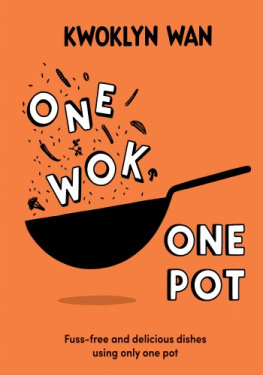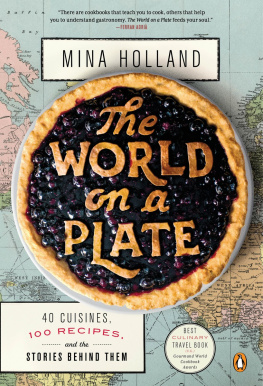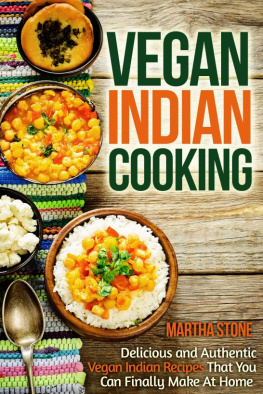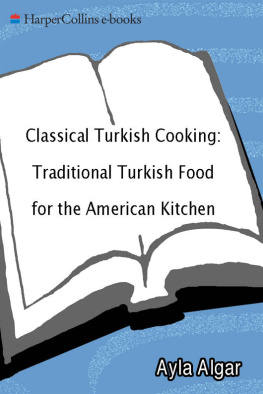CONTENTS
To my lovely Toufic and my family Conor, Kitty and Scarlett, my mum Maev and my late father John, brother Matt and family who have all made the journey so much fun and who have (almost) always revelled in my delicious new finds.
Welcome to the culinary United Nations
This beautiful book aims to lead you by the hand through some of the most delicious and intriguing foods around the world. With its help you can become the food-savvy companion others turn to and ask, How much zaatar should I buy at one time?, What sort of chilli do I need for my Thai red curry? and What the hell do I do with okra?!
In these pages lie some of the secrets behind thirty-four different cuisines that are all represented in Australias rich and diverse society. They include mouth-watering descriptions of traditional herbs and spices, seasonal vegetables, favourite drinks and snacks as well as tips on key ingredients and cooking implements. The recipes are simple, delicious and will always work and will impress your family and friends. They have been gathered from talented cooks and chefs who have grown up learning from their mothers and grandmothers their kitchen wisdom brings each cuisine alive.
So how did this exciting food adventure start? Well, many years ago I realised that my culinary boundaries growing up in a meat-and-threeveg IrishAustralian family were fairly limited. I was always keen to explore more exotic flavours so Ive gradually discovered and been welcomed into a world full of big, boisterous families and tables groaning under amazing food. It has been an honour to be included at the table of so many warm and welcoming new friends and Ive enjoyed a delicious adventure at the same time.
I hope youll love all of these new tastes and flavours and I wish you many delicious adventures of your own.
Maeve OMeara
What an incredible mix of cooking styles, unusual ingredients and delicious surprises are found in this vast continent. Having travelled in the north and south of Africa, I have a keen interest in African food and have been lucky enough to have taken part in preparing it many times. Yet I was still blown away by the discoveries Ive recently made closer to home. The marvellous spice mixes, deeply satisfying dishes, unusual serving arrangements and the sheer warmth and generosity of the African people Ive met have been overwhelming where one dish was enough, a whole feast would appear just because I showed an interest. Such generosity from people who come from a continent so often beset with natural and man-made disasters It says something about the human spirit that dishes that have evolved in Africa are not just sustaining but truly magnificent.
The West
West Africans love chilli and spices and will use these to add a little heat and extra flavour to many of their dishes. Ghanaians have developed a hot chilli and smoked fish accompaniment called shitto (yes, really!). It is an intensely smelly, wonderfully hot and salty paste that they use readily, even enjoying it simply with plain rice.
Red palm-fruit oil is the oil of choice in West Africa, and when its heated, magic happens. The oil melts to the most wonderful, deep-ruby colour and it adds a golden crispiness to anything cooked in it. One of my great finds has been disks of plantain (green banana) fried in palm-fruit oil, like chunky potato chips divine! This oil is often confused with its infamous, trans-fatty cousin made from the kernels of the palm oil tree. Palm-fruit oil comes from the fruit, which is pressed with the same technique used to make virgin olive oil, without any heat or solvents. As a result, the palm-fruit oil is high in betacarotene and antioxidants and is actually good for you.
The Horn
Ethiopia, Eritrea and Somalia are home to injera, a wonderfully spongy, fermented bread that is a cross between a crumpet and a pancake and the size of a wide circular tray. Its baked on a large, flat griddle and almost every meal is served on it, the round flatbread working as an edible plate the diner breaks off pieces of the bread to scoop up meat or vegetable stews.
One of the dishes I love is an Ethiopian slow-cooked stew called a wat. It starts with many kilograms of diced onions (chopping these is a tearjerker!) that are slowly cooked in a heavy-based pot for more than an hour. No oil or fat is used to start the cooking process and what you end up with is a sweet, dark base of onion to which lots of the popular berbere spice is added, as well as other spices and meat or vegetables. The resulting stew is spicy and delicious, especially served with injera.
Another great Ethiopian tradition is the coffee ceremony, which is a crucial part of social and cultural life there this is fitting, perhaps, as coffee was first discovered growing wild in Ethiopia centuries ago. Surprisingly, the green coffee beans are only roasted just before theyre used. Enough beans for each pot are poured into a small metal pannier and roasted over a flame, then the beans are ground and water is added. The resulting brew has a deliciously soft flavour, which is sometimes intensified by the addition of spices, including kibbled ginger. The coffee ceremony involves the serving of three rounds of coffee accompanied by the burning of frankincense. Its a heady feast for the senses and takes at least an hour very different from the Italian espresso you gulp while standing up in a coffee bar! No coffee ceremony is complete without popcorn and sometimes dates and a sweet, soft bread called himbasha are also served.
The East
Along the Swahili Coast of Kenya and Tanzania you find a wonderful culinary fusion of African, Indian, Arabic and British flavours, a legacy of spice trading in the area. Local produce such as fish, bananas and coconuts feature prominently and these are mixed with the more exotic tastes of curries, pickles, saffron, nutmeg and pomegranate. The Portuguese also had an impact on the cuisine of the region, as seen in the marinating and barbecuing techniques used there.
Further inland, cattle-breeding tribes like the Maasai live on a meat and milk-based diet, although maize meal, rice, potatoes and cabbage are becoming popular. In Uganda staple foods are steamed plantains called matoke, cassava, sweet potatoes, peanuts and beans. Simple and delicious food.
Making Fufu
In Africa, no meal is complete without a starchy porridge called fufu (also known as ugali, pap, iwisa, sadza or mealie meal). This is made from yams and sometimes plantains, cassava or maize and African people say they dont feel full unless theyve had their fufu
Making fufu to the required consistency takes some energy. Dried, pounded meal is mixed with water in a saucepan, which is placed over a fire or gas flame. As the fufu heats and thickens, the cook uses a large wooden spoon to stir it vigourously in a circular motion. It takes a good ten minutes to get the fufu just right thick and smooth. When cooked it is scooped by the cupful into a bowl and, with a few spoonfuls of warm water added, is shaken back and forth until it forms a ball. Its then served with a little meat or some vegetables in a rich sauce on the side.
It takes practice to eat fufu with your hands. You pinch off a ball with your right hand, making an indentation with your thumb and at the same time not letting it touch the palm of your hand. You then deftly scoop up a small amount of the accompanying stew and eat. Lets say its a delightful, tactile learning experience!











